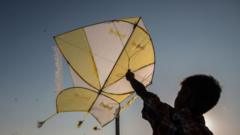At a paddy field just two kilometers from Jakarta's bustling Soekarno-Hatta International Airport, the peaceful joy of kite flying is interrupted by the loud departure of aircraft overhead. A group of children enthusiastically controlling their kites watches the skies, but they are equally vigilant, knowing that airport officials are nearby, ready to confiscate their beloved kites.
Seven-year-old Atif recounts, "In the past, my friends and I would run away when an officer came. Now I'm braver, so I just endure the scolding. If my kite is taken, I feel sad, but I can always create another one." This tension exemplifies the ongoing struggle between the excitement of kite flying, an Indonesian cultural staple, and aviation safety.
With summer break in full swing, kite flying becomes increasingly popular, yet authorities vehemently caution against it. They argue that wayward kites can interfere with aircraft operations, citing recent issues where kites disrupted 21 flights at Soekarno-Hatta in just three days. These incidents have led to diversions and aborted landings, posing a significant risk to aviation.
Putu Eka Cahyadi, head of the airport authority, emphasizes, "Kites are serious risks to flight safety. We must prevent accidents." Notable incidents underline these warnings: A helicopter collision with kite strings in 2024, injuries incurred, and debris found in a plane's engine in 2020. In response, officials established a task force five years ago to curb kite flying near airports.
Transportation minister Dudy Purwagandhi has urged greater collaboration among regional governments and airport authorities to mitigate risks while still recognizing the cultural importance of kite flying in Indonesia. Expert Asep Irawan states that the tradition is deeply ingrained, used in various ceremonies and for pest control, posing a challenge in balancing heritage with safety.
Legal penalties are severe for those caught engaging in kite flying near airports, with fines reaching one billion Indonesian rupiah or incarceration for up to three years. Unfortunately, kites pose dangers even in urban areas; a young boy lost his life while chasing a kite on a busy road last year.
As urban development consumes Jakarta's green spaces, kite enthusiasts feel increasingly pressured to remain at the paddy field, their designated community hub for competitions and leisure. Rasha, a 17-year-old, notes, "There's nowhere else to go," illustrating the scarcity of spaces dedicated to this cherished pastime.
Despite past warnings and confiscations, the children are determined to continue flying kites, believing that the enthusiasm for their tradition supersedes the risks involved in sharing the skies with airplanes. "It is pretty dangerous," Rasha admits, but for him, the thrill of kite flying carries a measure of freedom that is hard to forsake.
Seven-year-old Atif recounts, "In the past, my friends and I would run away when an officer came. Now I'm braver, so I just endure the scolding. If my kite is taken, I feel sad, but I can always create another one." This tension exemplifies the ongoing struggle between the excitement of kite flying, an Indonesian cultural staple, and aviation safety.
With summer break in full swing, kite flying becomes increasingly popular, yet authorities vehemently caution against it. They argue that wayward kites can interfere with aircraft operations, citing recent issues where kites disrupted 21 flights at Soekarno-Hatta in just three days. These incidents have led to diversions and aborted landings, posing a significant risk to aviation.
Putu Eka Cahyadi, head of the airport authority, emphasizes, "Kites are serious risks to flight safety. We must prevent accidents." Notable incidents underline these warnings: A helicopter collision with kite strings in 2024, injuries incurred, and debris found in a plane's engine in 2020. In response, officials established a task force five years ago to curb kite flying near airports.
Transportation minister Dudy Purwagandhi has urged greater collaboration among regional governments and airport authorities to mitigate risks while still recognizing the cultural importance of kite flying in Indonesia. Expert Asep Irawan states that the tradition is deeply ingrained, used in various ceremonies and for pest control, posing a challenge in balancing heritage with safety.
Legal penalties are severe for those caught engaging in kite flying near airports, with fines reaching one billion Indonesian rupiah or incarceration for up to three years. Unfortunately, kites pose dangers even in urban areas; a young boy lost his life while chasing a kite on a busy road last year.
As urban development consumes Jakarta's green spaces, kite enthusiasts feel increasingly pressured to remain at the paddy field, their designated community hub for competitions and leisure. Rasha, a 17-year-old, notes, "There's nowhere else to go," illustrating the scarcity of spaces dedicated to this cherished pastime.
Despite past warnings and confiscations, the children are determined to continue flying kites, believing that the enthusiasm for their tradition supersedes the risks involved in sharing the skies with airplanes. "It is pretty dangerous," Rasha admits, but for him, the thrill of kite flying carries a measure of freedom that is hard to forsake.


















